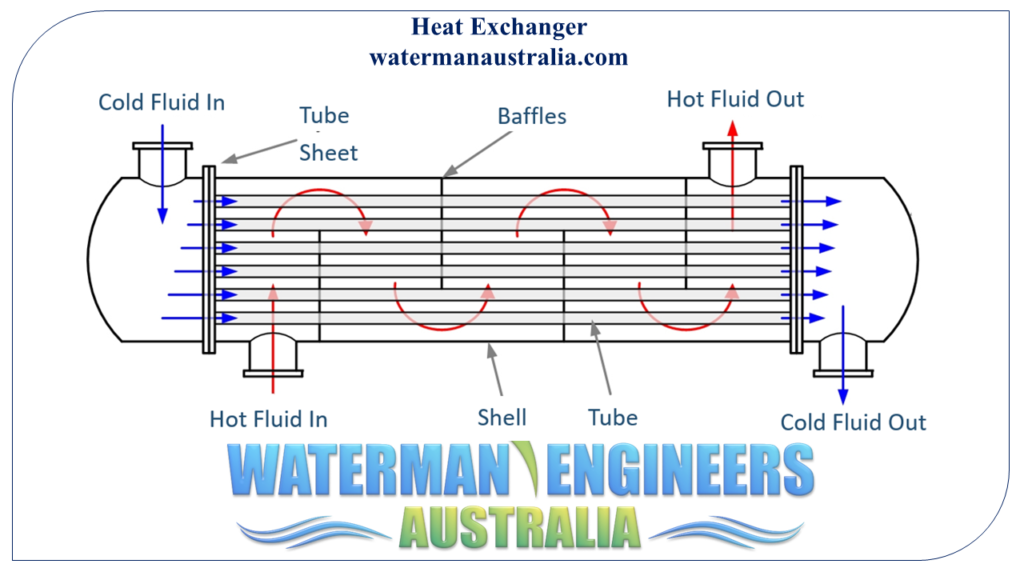
A heat exchanger is a device that allows for the transmission of heat between two different media without any physical contact between them. Heat exchangers work on the idea that thermal energy can be transferred from a hot fluid to a cold fluid. Heat exchangers provide for precise temperature regulation, improving energy efficiency and system functionality by transferring heat between two fluids.
Power plants, chemical plants, HVAC (heating, ventilation, and air conditioning) systems, supermarkets, and many more all employ heat exchangers. They can be found in commonplace home products like air conditioners and water heaters.
In this article, we'll learn about heat exchangers, what they are, how they work, and the different kinds there are. The article also details the common uses and factors to consider when choosing a heat exchanger.
For soiled and viscous fluids, the fouled strain fall in the heat exchanger is usually approximately thrice the thoroughly clean pressure fall, both equally within and outdoors tubes. Maintaining velocities significant more than enough to stay away from deposits, averting stagnant location/sizzling place/chilly place are mitigation actions in heat exchanger thermal design. From the HTRI software program, fouling layer thickness might be entered instantly.
A fluid with tendency to foul should also be place around the tube facet, which can be simpler to cleanse: Cleaning the inside of (straight) tubes is simpler than cleansing the shell/outside of the tubes
In the event that both equally fluids are fouling, each straight tubes and detachable bundles are expected, therefore the costliest floating-head (AES) sort must be chosen. This type has by far the most maintainability and access to both sides; In the meantime this configuration needs the most forging and sealing surfaces, and quite possibly the most machining or grinding surfaces. The consequence of getting the highest number of removable sections is that it is also the costliest.
“You will discover hardly any elements as well as less fabrication techniques which will manage All those pressures and temperatures,” Narayanan reported.
The Contactor: The contactor is basically a Regulate which is applied to have the voltage switched on your furnace heating factor. It really works specifically with the thermostat, that means if the thermostat doesn’t have a very superior voltage, the contactor might be energized by it.
Figure four displays a standard nozzle in average assistance, with reinforcement provided by a reinforcement plate and that has a weld neck nozzle flange.
Exception: The above mentioned elements are the foremost variables in selections generating. They may, on the other hand, have effects on each other and make the fluid allocation more difficult.
In the event the temperatures start to drop within the winter months, your furnace may struggle to maintain a snug temperature in your house. Though that may often mean that you need a new furnace, it most frequently means that one particular of one's furnace parts could reap the benefits of slightly maintenance.
Log-mean temperature change ΔTlm is computed beneath assumption of counter circulation situations. Heat transfer price is
Harm that occurs to the heat exchanger will allow exhaust gasoline to escape and contaminate your own home with carbon monoxide.
Sketches of your air consumption specialized House built previously mentioned floor and on the airflow pathway while in the pipes ended up superimposed on to the photograph.
Fluids with large temperature change throughout a single move shall be Positioned around the shell aspect to decrease the axial Designing of heat exchanger manufacturer compressive tension and avoid the expansion joint.
Tube cleaning which has a welded channel bonnet (TEMA front conclude B) would need the breaking and remaking on the channel nozzle flanges to allow the channel for being removed. A flat head (TEMA front end A) avoids this and permits the pipework to stay in position.
If the first and secondary fluids movement in the other way, then this is known as “counter-movement”. Also the inner heat pipe is usually possibly one bare tube, fitted with fins to improve the surface spot, or as being a multi-tube style and design as revealed.